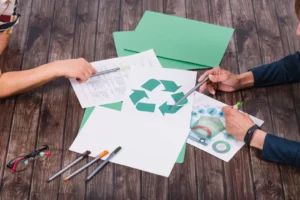Implementing Full Circle Recycle Programs
In a world facing escalating environmental challenges, the concept of a circular economy has gained great popularity as a sustainable alternative. A circular economy attempts to minimize waste, reduce resource consumption, and promote ongoing reuse and recycling of commodities. One of the essential components of this method is the installation of full circle recycle programs. In this blog article, we’ll delve into the concept of a circular economy and study how full circle recycle programs play a crucial role in its effective implementation.
Understanding the Circular Economy
The classic linear economy follows a “take, make, dispose” model, where resources are harvested, employed to generate products, and eventually disposed as waste. On the other side, a circular economy tries to close the cycle by designing out waste and pollution from the outset. It stresses lengthening the life cycle of items and resources through tactics such as recycling, refurbishment, and repurposing.
The Role of Full Circle Recycle Programs
Full circle recycle initiatives are at the forefront of the circular economy movement. These programs aim on developing a closed-loop system in which materials are gathered, processed, and reused to create new goods. Here’s how they work:
Collection and Sorting:
Full circle recycle programs begin with gathering and sorting recyclable items, such as plastics, glass, paper, and metals. Advanced sorting methods ensure that materials are isolated effectively, decreasing contamination and improving the quality of recovered resources.
Processing and Refining:
After being gathered, recyclable materials are put through a series of processes, including processing and refining, which converts them into raw materials or feedstock. This includes activities such as cleaning, shredding, and refining the materials in order to get them ready for reuse.
The Process of Creating New Products:
After the materials have been refined, they are utilized in the production of brand new goods. When creating goods with the desired qualities of quality and performance, it is often necessary to combine recycled materials with elements that have not been used before.
Completing the Circuit:
The ultimate objective of recycling programs that go the whole circle is to complete the cycle by selling recycled goods again. This will bring the loop full circle. As a result, there is less of a demand for virgin resources, and the amount of trash produced is cut down significantly. These items become new consumer commodities.
Advantages to Participating in Full-Circle Recycling Programs
The following are some of the environmental, economic, and social benefits that can be gained through implementing full circle recycling programs:
- Full-Circle Recycling Programs Conserve Important Natural Resources By Recycling Materials These programs conserve important natural resources by recycling materials. This reduces the demand for resource extraction and preserves ecosystems.
- garbage Reduction: These initiatives lower the amount of garbage that ultimately winds up in landfills or incineration facilities by a large amount, hence limiting the negative effects of waste disposal on the environment.
- Savings on Energy: The processing of recycled materials uses significantly less energy than the processing of virgin resources, which contributes to a reduction in the emissions of greenhouse gases.
- Job Creation: Full circle recycling initiatives have the potential to provide new employment opportunities in recycling facilities, product production, and material processing.
- Savings on Production Costs: Using Recycled Materials can frequently result in lower production costs, which in turn makes products more competitive on the market.
The Obstacles in Our Way and the Way Forward
Although full circle recycling programs provide some promising solutions, there are still many obstacles to overcome, including a lack of consumer awareness, inadequate recycling infrastructure, and technological limitations. Despite this, addressing these difficulties and moving the circular economy ahead can be accomplished by ongoing innovation, investments in recycling infrastructure, and increased public awareness.
The final word
By repurposing previously discarded materials into useful products, full-circle recycling operations show the concepts behind a circular economy. These programs contribute to the preservation of resources, the reduction of waste, the savings of energy, and the expansion of the economy by placing an emphasis on the continual reuse and recycling of materials. Implementing and extending full-circle recycling programs will play a crucial part in developing a society that is more ecologically responsible and resilient as the globe searches for sustainable solutions for the future.







